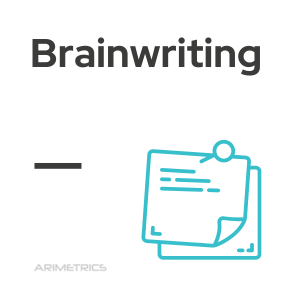Definition
Brainwriting is an idea generation technique in which participants write down their ideas on paper instead of sharing them verbally in a brainstorming session. Unlike traditional brainstorming, in which participants share their ideas out loud, brainwriting allows participants to work independently and write down their ideas individually.
This technique facilitates participation and allows participants to reach a considerable level of depth in their ideas, which can generate more creative and innovative solutions. In addition, Brainwriting is a more inclusive technique, as it gives introverted participants the opportunity to share their thoughts without having to speak in public.
Advantages of Brainwriting
Among the benefits of using this technique we can mention the following:
- Encourages equal participation: Unlike traditional brainstorming in which few people can monopolize the process, brainwriting provides the opportunity for all participants to share their ideas individually without fear of being judged negatively. This increases the diversity of ideas and promotes greater creativity in the group.
- Allows you to dig deeper into ideas: By writing down your ideas, participants have more time to reflect and deepen their thoughts. This can lead to more innovative and effective solutions.
- Create a calmer, more focused environment: By working independently and quietly, participants can better focus on their ideas without feeling influenced by the group or pressured to share their thoughts publicly.
- Increases the quantity and quality of ideas: According to studies, groups that use Brainwriting generate up to 20% more ideas than in traditional brainstorming. In addition, this technique avoids repetition and overlapping of ideas, since participants can read and build on each other’s ideas.
- Include introverts: Brainwriting provides a more inclusive way for introverted participants to share their ideas without having to speak in public or compete for group attention.
Difference between Brainwriting and Brainstorming
In traditional brainstorming, participants share their ideas out loud, which often means that only a few dominants monopolize the process. In addition, participants may feel more concerned about judging others negatively than generating high-quality ideas of their own. This dynamic can lead to a lack of diversity of ideas and limit the creativity of the group.
On the other hand, brainwriting allows individuals to work independently and quietly, which creates a quieter and more concentrated space for idea generation. Each participant has the opportunity to develop their own ideas together with other people while not feeling pressured by the group.
In addition, Brainwriting increases the number of ideas generated. According to one study, groups that used brainwriting created 20% more ideas than groups that used traditional brainstorming. This technique also helps avoid overlapping and repetition of ideas, as participants can read what others have written before adding their own.
In short, brainwriting offers a more inclusive and effective way to generate ideas compared to traditional brainstorming. It allows individuals to work independently, focus better on generating ideas and create a greater number of unique and creative ideas.
